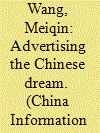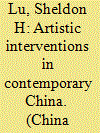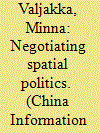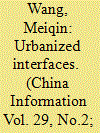|
|
|
Sort Order |
|
|
|
Items / Page
|
|
|
|
|
|
|
| Srl | Item |
| 1 |
ID:
140506


|
|
|
|
|
| Summary/Abstract |
Consumerism is a central feature of urbanism in China and has been actively promoted as a sign of urbanity in the official rhetoric and mass media. This urban ideology is exemplified by the ubiquitous presence of street advertisements that often occupy prominent urban public spaces. After all, turning every citizen of China into a consumer has become a widely accepted Chinese dream and one that is employed to mobilize a population otherwise divided by the ever-widening gap between the rich and poor. Advertisements have assumed a commanding role and are utilized by both official entities and private corporations to promote all kinds of urban consumption, ranging from concrete commodities such as high-end homes, beautiful neighbourhoods, and luxurious goods to intangible symbols such as lifestyle, ideology, and cosmopolitan identity. All these have fallen under the scrutiny of the Shanghainese artist Ni Weihua, whose photography documents billboards advertising official ideologies and real-estate projects in Shanghai and other cities. This study brings into context Ni’s artistic practice and examines specific ways in which his photographic series Keywords (关键词) and Landscape Wall (风景墙) engage with formal advertisements in the street both as an urban reality and as a site for deconstruction.
|
|
|
|
|
|
|
|
|
|
|
|
|
|
|
|
| 2 |
ID:
140510


|
|
|
|
|
| Summary/Abstract |
This concluding article examines the ways in which Chinese artists depict, decipher, and react to urbanization in contemporary China. It summarizes several important themes in the cluster of articles included in this special issue of China Information. First, Chinese artists navigate the complex relationship between art and society, namely the tension between the individual aspirations of artists on the one hand and the limits of tolerance in Chinese public culture on the other hand. Second, the artists feel compelled to negotiate with and make sense of the Janus-faced reality of China: rosy images of a forward-looking society as painted by the official media in contrast to the plight of marginal social groups who have not been able to benefit from China’s march to prosperity. Third, the artists attempt to find the right balance in artistic expression between localism and globalization, namely, between the indigenous roots of their art and the pressures and opportunities afforded by the global capitalist economy and the international art market.
|
|
|
|
|
|
|
|
|
|
|
|
|
|
|
|
| 3 |
ID:
140507


|
|
|
|
|
| Summary/Abstract |
This article examines the moving image works of Chinese artist Cao Fei as a response to China’s rapid urbanization and the transformation of its existing urban spaces which are no longer shaped by socialism but instead by what this article considers as China’s engagement with neo-liberalism, including and facilitated by globalization. The urban sprawl of the Pearl River Delta inspired Rem Koolhaas’s writings on the ‘generic city’, which he celebrates precisely for its blandness. Cao herself is from Guangzhou. Yet, in works such as RMB City, Haze and Fog, Whose Utopia, and Hip Hop: Guangzhou, Cao creates what she calls ‘magical metropolises’. This article asks what kind of responses Cao’s ‘magical’ works are to contemporary Chinese urbanization. As part of the answer to this question, it applies four hermeneutic frameworks to analyse the works themselves. The findings from each of those frameworks indicate that Cao’s work not only reflects the current Chinese urban condition, but also participates and intervenes in it in various ways.
|
|
|
|
|
|
|
|
|
|
|
|
|
|
|
|
| 4 |
ID:
140508


|
|
|
|
|
| Summary/Abstract |
The focus on Beijing’s speed of development and the concomitant fascination with the unchecked destruction of hutongs reveal only part of Beijing’s urban story. If we consider that migrant workers (农民工) are the ‘human infrastructure’ that enables the built infrastructure, then grappling with how contemporary artists depict, exploit, and represent this human infrastructure uncovers many previously overlooked stakeholders. Artists reflect, recombine, and reimagine the figure of the migrant worker. However, such artistic interventions, while a critical avenue for addressing the contested citizenship of urban dwellers, are only one facet of the complex visual field of Beijing. Therefore, in addition to these artists’ works, I discuss other visual elements of Beijing such as the scrawled phone numbers advertising a variety of services for migrant workers on the surfaces of Beijing’s built environment. This unsigned public calligraphic practice is considered alongside the art of globally recognized artists to probe the interconnectedness of urban visual practices, question the targeted constituencies, and examine their reception by a range of urban audiences, revealing the communicative potential of images and text in the urban context and questioning what is at stake for the networks of migrant workers in Beijing that are often invisible.
|
|
|
|
|
|
|
|
|
|
|
|
|
|
|
|
| 5 |
ID:
140509


|
|
|
|
|
| Summary/Abstract |
Since the mid-1990s, growing urbanization has led to the rise of new forms, needs and sites for visual self-expression in urban public space in mainland China. Drawing on periods of intensive fieldwork in Beijing, Shanghai, Shenzhen and Hong Kong since 2006, this article suggests a new approach for examining the spatial politics of urban art images in China based on the concept of ‘site responsiveness’. Inspired by discussions on site-specific and site-oriented art and street art, this article aims to clarify the importance of both aesthetic analysis and comparative contextualization of urban art images in relation to (1) the reciprocal relationship between the urban art images and the site, and (2) international developments in the discourses on ‘graffiti’ and ‘street art’. This dual approach provides a starting point for a comprehensive sociospatial interpretation of the visual phenomenon in China while challenging the unproblematized use of the concept of graffiti in existing studies and offering two umbrella concepts – urban art images and creator of urban art images – to facilitate more nuanced research. By examining actions of visual self-expression at the grass-roots level, this article brings attention to an often neglected but crucial perspective to discussions of the city as a living organism and to the interrelations between art and urbanization.
|
|
|
|
|
|
|
|
|
|
|
|
|
|
|
|
| 6 |
ID:
140505


|
|
|
|
|
| Summary/Abstract |
Urban transformation in China has been hailed as a revolution. The pace and scale of change as well as the grand narrative of transformation have been characterized in terms of superlatives – the tallest skyscrapers, the largest shopping malls, the longest bridges and highways, the fastest trains – testifying to the teleology and progress of China’s dream of prosperity. However, behind the sleek and glittering façade lies a story of exclusion, violence, dispossession, and destruction – the ruins of a civilization. This article engages with this side of the story by exploring the dialectic between urban transformation and the parallel development of the visual arts, which has created new regimes of visibility and new hierarchies of representation. In new and large cities alike, the visual arts have been manifesting affections that permeate the contemporary world, creating new possibilities for ‘distributing the sensible’. This article focuses on the artworks produced by Zhang Dali, Dai Guangyu and Jin Feng, whose subject matter involves common people, and it engages with three crucial discursive formations: violence, socio-economic inequality, and utopian dreams. These artists are producing a ‘history from below’ (to borrow E. P. Thompson’s expression): rescuing the common people from ‘the enormous condescension of posterity’. They are making ordinary people assume the importance of the extraordinary. From the point of view of aesthetics, they are enacting a total revolution of the senses and, in Rancière’s words, making ‘heard as speakers those who had been perceived as mere noisy animals’.
|
|
|
|
|
|
|
|
|
|
|
|
|
|
|
|
| 7 |
ID:
140504


|
|
|
|
|
| Summary/Abstract |
In the past two decades, unparalleled urbanization in cities across mainland China has deeply affected and transformed Chinese visual arts. Critical artistic and creative examinations of the interfaces between urbanization, society, culture, arts and people in Chinese cities have produced a great variety of new visual forms and agencies. In this introductory essay, we argue that the complexities of reciprocal relationship between urbanization and the visual arts deserve greater scholarly attention than they have been given so far, and we call for continuous and multiple-perspective research into the subject. The visual arts not only mirror the city but they actively participate in city-making processes. The investigation of artists, filmmakers and urbanites into the changing urban space in which they live has given birth to a post-socialist urban aesthetics, which, as Robin Visser proposes, functions as a new realm to envision, experience and assess the city. In doing so, it enables new forms of civic agencies to emerge. Visual art, as indicated by Yomi Braester in his study of Chinese films, interacts with political decisions and architectural plans, creating both material and ideological constructs of the cities. We maintain that the varied forms of visual arts and agencies discussed in this special issue not only reveal and interpret how the processes of globalization and urbanization are interrelated, but also participate in the reconstruction of sociospatial relationships and the reconceptualization of the city at local, national, and even global levels.
|
|
|
|
|
|
|
|
|
|
|
|
|
|
|
|
|
|
|
|
|